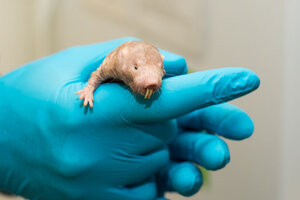Death-defying naked mole rat: How does it do it?
The secret to the rodent's long life could be in its highly unusual ribosomes, according to a new paper published in PNAS.

Naked mole rats can live for almost three decades, about eight times as long as their like-sized compatriots, mice. Scientists believe that understanding why these unusual rodent alive so long could help combat human aging.
J. Adam Fenster/University of Rochester.
Compared with humans, its heart rate is low, its little lungs are sluggish, and its metabolism is downright pokey. Its skin, pink and hairless and rugous, sags like wet paper from its tubular frame.
The naked mole rat looks from birth to death as though it were always close to the latter. But this geriatric façade belies the fact that the naked mole rat can live to be upwards of 28-years-old, about eight times longer than a mouse, its rodent equivalent in size.
For that reason, the naked mole rat has been in recent years pushed out of its East African burrows and into the scientific limelight, in hopes that it could answer a question that at face value seems an unusual one to ask of an ugly rodent: What can this critter teach humans about the nature of longevity?
“The naked mole rat isn’t just something we study out of curiosity – it’s useful,” says Vera Gorbunova, a researcher at the University of Rochester and a co-author on a new paper published in Proceedings of the National Academy of Sciences that plumbs the naked mole rat’s cells for the rodent’s well-kept secret to longer life.
That secret, the paper reports, might be in the rodent’s highly unusual ribosomes, the molecular, protein-producing machines found in the cells of living organisms.
But before tucking into the unusual nature of the naked mole rat’s cells, there are some more obvious reasons for its long life. The primary explanation is the naked mole rat's adaptive traits which keep it underground, out of the reach of predators that snap up mice and away from the myriad above-ground accidents that can befall other rodents.
If there is any lethal drama to a naked mole rat’s existence, it is the sporadic civil wars that roil its own social unit. The naked mole rat is highly unusual among mammals in that it is a eurosocial animal: it lives in large, stratified groups, much as ants and bees do. Usually, these groups are cooperative – until the group’s queen dies. Then, the female rodents will tussle for the role of sole breeder, a plum position that comes with a coterie of attendant males.
But once the new queen is installed, the colony settles back into its usual, slow rhythm. And naked mole rats that weren’t felled during the competition can, well, expect to live a very, very long time.
Still, researchers have suspected that the naked mole rat’s protected habitat is an inadequate explanation for its protracted life. Something more, they say, must be keeping the animal not just alive but also healthy well into its late twenties – long after even the most hardy mice have succumbed to old age.
In June, Gorbunova’s team reported in Nature that the naked mole rat produces an unusual compound that protects it from cancer (not a single instance of the disease has never been recorded in the rodent). During that research, as they peered into the rodent’s cells, the team came upon another surprise: the naked mole rat’s ribosomes are not structured like those of almost any other animal.
A ribosome is a cell’s protein synthesizer, and a ribosome is scaffolded with molecules called ribosomal RNA, or rRNA. In vertebrates, each ribosome has three rRNAs. But a mole rat’s ribosomes have four rRNA molecules, the researchers found. That’s because one of the rRNAs in a naked mole rat’s ribosome, the molecule called 28S, cleaves into two.
Just one other mammal, a distantly related, underground rodent called the tuco-tuco, is known to depart from the three rRNAs standard to have four such molecules, Gorbunova said. Little is known about this South American mammal’s lifespan, she said.
The naked mole rat’s curiously structured ribosome then raised another research question: Why? How does this unusual ribosomal architecture change how the ribosome produces proteins? And how might this relate to the naked mole rat’s longevity?
“This upsets the entire folding of the ribosome,” says Gorbunova, of the extra rRNA molecule. “We wanted to know what kind of effect that would have on protein production.”
In all living organisms examined to date, ribosomes are fallible: sometimes, a ribosome will insert an incorrect amino acid into the protein chain it’s making. But the researchers found that naked mole rat’s cells manufacture proteins that are up to 40 times less likely to contain mistakes than are a mouse cell’s proteins. In other words, a naked mole rat’s ribosomes are unusually faithful copiers, as precise as a cloistered Medieval scribe.
And in ribosomes, that precision apparently has life or death stakes, since protein errors are highly correlated with aging, says Gorbunova. While a young body has little trouble recycling out junk protein, an older body does so much less efficiently, allowing the junk to accumulate. This junk then clogs the cell and manifests as various diseases, she says.
Understanding the mechanism behind the natural fidelity in a naked mole rat's ribosomes could be important for longevity researchers, says Gorbunova.
And that means there's more work to be done. It’s unclear whether or not the extra rRNA molecule is the reason for the mole rat’s superior protein making, says Gorbunova. To find out, the researchers plan to cleave a mouse’s 28S rRNA molecule to see if the mouse’s cells also begin to produce less junky protein, she says.

